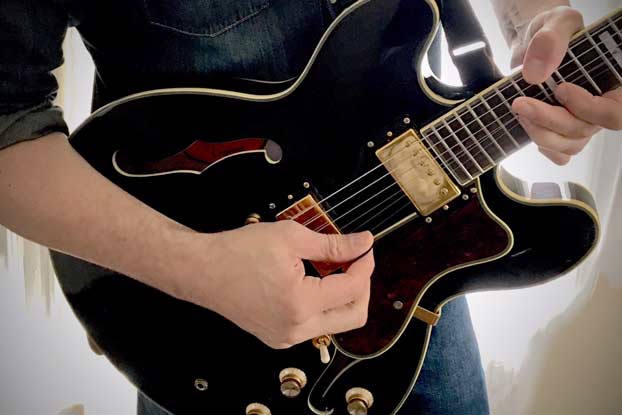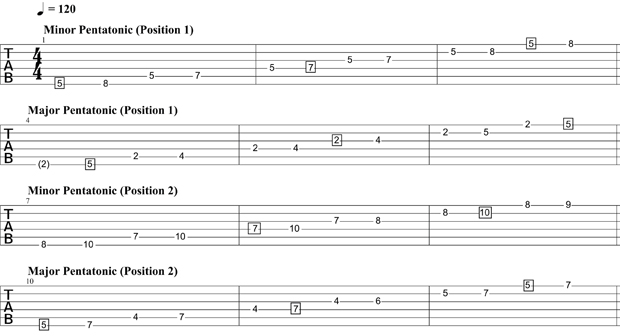Essential Blues Basics: Soloing with the Combined Minor/Major Pentatonic Scales
Become a more versatile player by learning how to combine the minor and major pentatonic scales.

One key to becoming a more versatile blues soloist is learning to combine the minor pentatonic and major pentatonic scales to create guitar lines that go beyond the minor pentatonic scale.
As a prerequisite to this lesson, you should have a basic understanding of the finger positionings for the minor pentatonic and major pentatonic scales, particularly the first and second positions of both scales.
Stepping back, I should note that learning to play within both of these scales at the same time opened new doors for me as a guitar player.
Before combining them, I remember first learning to solo over the standard 1-4-5 blues progression, and my teacher at the time gave me a quick trick for alternating between the minor and major pentatonic solos: Use the minor pentatonic for the sections on the “1” and the major pentatonic for the sections on the “4," and alternate back in forth in this manner in the way that sounded best.
While this approach can work to give you a more varied sound beyond merely the minor pentatonic scale, this trick is by no means a hard and fast rule, and moving beyond it to learn to combine both scales makes you a more versatile player.
A quick point of reference to understand about these scales is that, in respect to physical finger positioning, they are identical, with one scale simply falling three frets below the other on the fretboard. That is to say, in any given key: (i) the finger position for the major pentatonic scale falls three frets down from the minor pentatonic scale, and (ii) the root note is the same for both scales.
So, for example, let’s focus on the key of A. The A on the fifth fret of the first string is the root note of both the A minor pentatonic and A major pentatonic scales.
This means that, in the A minor pentatonic scale’s first position, the A on the fifth fret of the first string is played with your index finger. And, three frets down playing the same positions for the A major pentatonic scale, the same A is played with your pinky (and your index finger is on the F#—you may also notice at this point that you are in the F# minor pentatonic scale’s first position). The below tabs illustrate this point.

So, first visualize both major and minor pentatonic scales, and practice them up and down the neck, focusing on their first and second positions for the purposes of this lesson. You can practice them with all downstrokes and/or alternate picking, and in doing so, keep in mind the locations of your root note A’s, which are relevant for playing blues in the key of A.
As you will notice, the first position of the A minor pentatonic scale and the second position of the A major pentatonic scale are both within easy reach of the first position of the A minor pentatonic scale (index finger beginning on the fifth fret of the first string, and proceeding on from there). And, as you see below, these scale positions can be overlayed into a hybrid scale that encompasses all of their notes. And, what we want to learn how to do is visualize the first position of the minor pentatonic scale and the second position of the major pentatonic over the same position on the neck, and use the notes from both scales to play blues licks and riffs.

So, to make a riff using both scales, let’s focus on the top two strings starting at the fifth fret. The A minor pentatonic scale uses the notes at the fifth and eighth frets on these strings, while the A major pentatonic uses the notes at the fifth and seventh frets on these strings. So, to combine the scales and see what it sounds like, let’s play the following lick No. 1.
And you can already hear the blues element present when you mix these scales. After you are comfortable with lick No. 1, you can move to lick No 2, which further explores this principle. And at this stage, I would encourage you to start exploring further and have some fun coming up with new licks using the notes from both scales in this position.

Another common lick that combines these scales using a hammer-on is shown below in lick No. 3, and you have probably heard this combination of notes in many country and blues songs.

So, bringing a lot of these elements together, you can play something like the following.

You can always play the scales separately to give your soloing their different flavors. And soon, taking this lesson into account, and with some practice, you will be able to bring these two scales together into a hybrid scale to further expand what you can play, and allow you to play modern blues and some old-school blues in what may be a new way for you.
The first step is to be able to see the two scales and then put them together, seeing the minor pentatonic and major pentatonic scales at the same time. As you’ll see, if you know all five positions of the pentatonic scale, you can apply this very same principle all over the guitar neck. And pretty soon the new notes from scale to scale will begin to stick out, giving you new notes to play all over the neck in your blues solos.
Steve Stine is a longtime and sought-after guitar teacher who is professor of Modern Guitar Studies at North Dakota State University. Over the last 27 years, he has taught thousands of students, including established touring musicians, and released numerous video guitar lesson courses via established publishers. A resident of Fargo, North Dakota, today he is more accessible than ever before through the convenience of live online guitar lessons at LessonFace.com.LessonFace.com offers live online music lessons via videoconference, allowing you to access top teachers in a wide variety of instruments from anywhere with a broadband connection. Steve is offering a live online group class for intermediate players this summer called “The Players Series” via the LessonFace.com platform. More information about live online lessons with Steve is available at lessonface.com/player.
Get The Pick Newsletter
All the latest guitar news, interviews, lessons, reviews, deals and more, direct to your inbox!
“There are so many sounds to be discovered when you get away from using a pick”: Jared James Nichols shows you how to add “snap, crackle and pop” to your playing with banjo rolls and string snaps
Don't let chord inversions bamboozle you. It's simply the case of shuffling the notes around







![Joe Bonamassa [left] wears a deep blue suit and polka-dotted shirt and plays his green refin Strat; the late Irish blues legend Rory Gallagher [right] screams and inflicts some punishment on his heavily worn number one Stratocaster.](https://cdn.mos.cms.futurecdn.net/cw28h7UBcTVfTLs7p7eiLe.jpg)


